经典Abaqus命令流分析
- 格式:pdf
- 大小:722.94 KB
- 文档页数:58
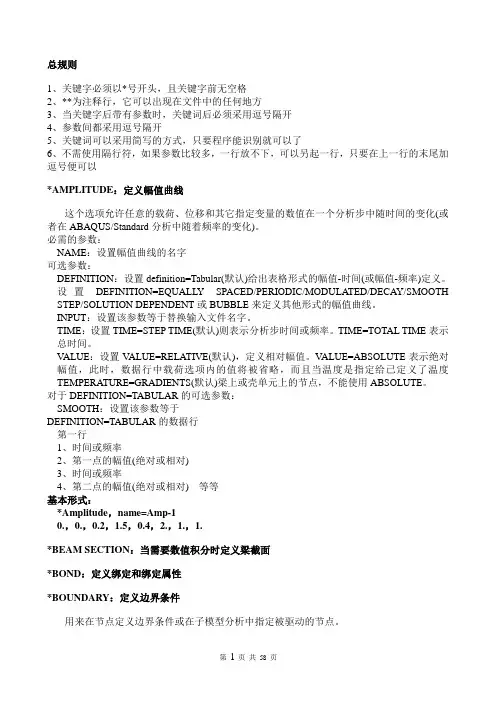
总规则1、关键字必须以*号开头,且关键字前无空格2、**为注释行,它可以出现在文件中的任何地方3、当关键字后带有参数时,关键词后必须采用逗号隔开4、参数间都采用逗号隔开5、关键词可以采用简写的方式,只要程序能识别就可以了6、不需使用隔行符,如果参数比较多,一行放不下,可以另起一行,只要在上一行的末尾加逗号便可以*AMPLITUDE:定义幅值曲线这个选项允许任意的载荷、位移和其它指定变量的数值在一个分析步中随时间的变化(或者在ABAQUS/Standard分析中随着频率的变化)。
必需的参数:NAME:设置幅值曲线的名字可选参数:DEFINITION:设置definition=Tabular(默认)给出表格形式的幅值-时间(或幅值-频率)定义。
设置DEFINITION=EQUALLY SPACED/PERIODIC/MODULATED/DECAY/SMOOTH STEP/SOLUTION DEPENDENT或BUBBLE来定义其他形式的幅值曲线。
INPUT:设置该参数等于替换输入文件名字。
TIME:设置TIME=STEP TIME(默认)则表示分析步时间或频率。
TIME=TOTAL TIME表示总时间。
V ALUE:设置V ALUE=RELATIVE(默认),定义相对幅值。
V ALUE=ABSOLUTE表示绝对幅值,此时,数据行中载荷选项内的值将被省略,而且当温度是指定给已定义了温度TEMPERATURE=GRADIENTS(默认)梁上或壳单元上的节点,不能使用ABSOLUTE。
对于DEFINITION=TABULAR的可选参数:SMOOTH:设置该参数等于DEFINITION=TABULAR的数据行第一行1、时间或频率2、第一点的幅值(绝对或相对)3、时间或频率4、第二点的幅值(绝对或相对) 等等基本形式:*Amplitude,name=Amp-10.,0.,0.2,1.5,0.4,2.,1.,1.*BEAM SECTION:当需要数值积分时定义梁截面*BOND:定义绑定和绑定属性*BOUNDARY:定义边界条件用来在节点定义边界条件或在子模型分析中指定被驱动的节点。
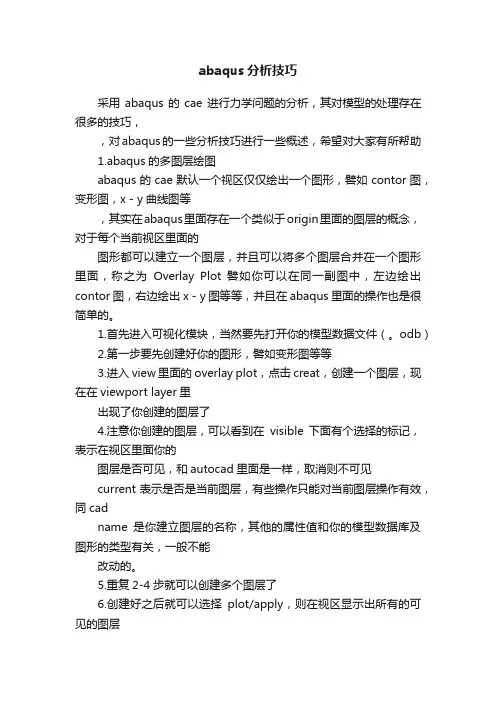
abaqus分析技巧采用abaqus的cae进行力学问题的分析,其对模型的处理存在很多的技巧,,对abaqus的一些分析技巧进行一些概述,希望对大家有所帮助1.abaqus的多图层绘图abaqus的cae默认一个视区仅仅绘出一个图形,譬如contor图,变形图,x-y曲线图等,其实在abaqus里面存在一个类似于origin里面的图层的概念,对于每个当前视区里面的图形都可以建立一个图层,并且可以将多个图层合并在一个图形里面,称之为Overlay Plot 譬如你可以在同一副图中,左边绘出contor图,右边绘出x-y图等等,并且在abaqus里面的操作也是很简单的。
1.首先进入可视化模块,当然要先打开你的模型数据文件(。
odb)2.第一步要先创建好你的图形,譬如变形图等等3.进入view里面的overlay plot,点击creat,创建一个图层,现在在viewport layer里出现了你创建的图层了4.注意你创建的图层,可以看到在visible 下面有个选择的标记,表示在视区里面你的图层是否可见,和autocad里面是一样,取消则不可见current表示是否是当前图层,有些操作只能对当前图层操作有效,同cadname是你建立图层的名称,其他的属性值和你的模型数据库及图形的类型有关,一般不能改动的。
5.重复2-4步就可以创建多个图层了6.创建好之后就可以选择plot/apply,则在视区显示出所有的可见的图层子结构1.什么是子结构子结构也叫超单元的(两者还是有点区别的,文后会谈到),子结构并不是abaqus里面的新东东,而是有限元里面的一个概念,所谓子结构就是将一组单元组合为一个单元(称为超单元),注意是一个单元,这个单元和你用的其他任何一种类型的单元一样使用。
2.为什么要用子结构使用子结构并不是为了好玩,凡是建过大型有限元模型的兄弟们都可能碰到过计算一个问题要花几个小时,一两天甚至由于单元太多无法求解的情况,子结构正是针对这类问题的一种解决方法,所以子结构肯定是对一个大型的有限元模型的,譬如在求解非线性问题的时候,因为对于一个非线性问题,系统往往经过多次迭代,每次这个系统的刚度矩阵都会被重新计算,而一般来说一个大型问题往往有很大一部分的变形是很小的,把这部分作为一个子结构,其刚度矩阵仅要计算一次,大大节约了计算时间。
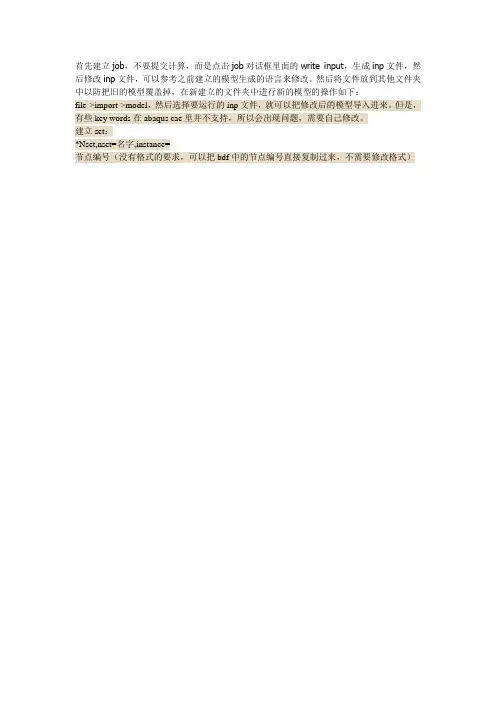
首先建立job,不要提交计算,而是点击job对话框里面的write input,生成inp文件,然后修改inp文件,可以参考之前建立的模型生成的语言来修改。
然后将文件放到其他文件夹中以防把旧的模型覆盖掉,在新建立的文件夹中进行新的模型的操作如下:
file->import->model,然后选择要运行的inp文件,就可以把修改后的模型导入进来。
但是,有些key words在abaqus cae里并不支持,所以会出现问题,需要自己修改。
建立set:
*Nset,nset=名字,instance=
节点编号(没有格式的要求,可以把bdf中的节点编号直接复制过来,不需要修改格式)。
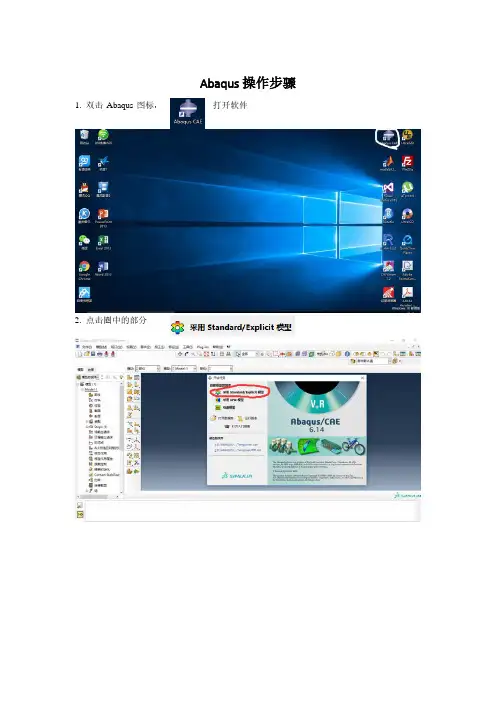
Abaqus操作步骤
1. 双击Abaqus图标,打开软件
2. 点击圈中的部分
3. 选择图中鼠标所在位置的下拉菜单中的第一项“部件”
4. 点击左侧工具条中右上角部件管理器,弹出如下对话框
5. 点击对话框中的创建按钮,弹出另一个对话框,选择“三维”、“可变形”、“线”、“平面”。
最下方的尺寸单位为毫米(mm),具体尺寸可以视实际情况改变。
6. 点击“继续”,然后弹出如下窗口,点击图中圈出“创建线”,然后画出自己的结构。
7. 然后选择下拉菜单的“属性”,点击“创建”,按下图顺序编辑材料的各种参数,点击“确定”。
8. 然后选择下拉菜单中的“装配”选项卡,按下图顺序操作
9. 然后选择下拉菜单中的“分析步”选项卡,按下图顺序操作。
10. 然后选择下拉菜单的“载荷”选项卡,按下图顺序操作。
11. 选择下拉菜单的“网格”选项卡,按照下图进行操作。
12. 选择下拉菜单的“作业”选项卡,按下图顺序进行操作。
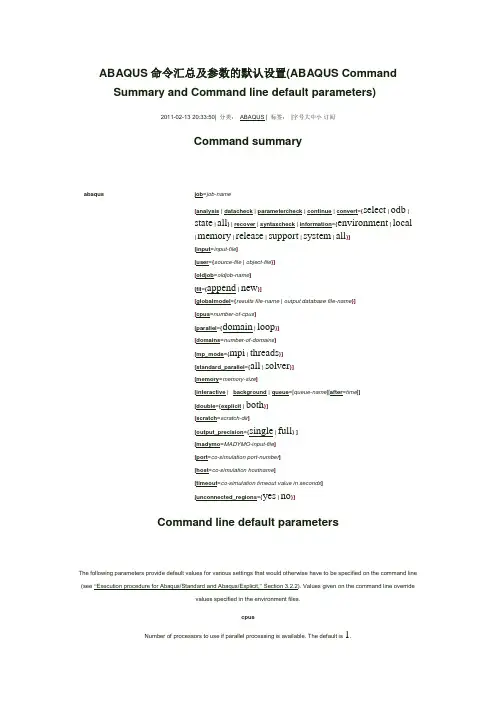
ABAQUS命令汇总及参数的默认设置(ABAQUS Command Summary and Command line default parameters)2011-02-13 20:33:50| 分类:ABAQUS | 标签:|字号大中小订阅Command summaryabaqus job=job-name[analysis | datacheck | parametercheck | continue | convert={select | odb |state | all} | recover | syntaxcheck | information={environment | local| memory | release | support | system | all}][input=input-file][user={source-file | object-file}][oldjob=oldjob-name][fil={append | new}][globalmodel={results file-name | output database file-name}][cpus=number-of-cpus][parallel={domain | loop}][domains=number-of-domains][mp_mode={mpi | threads}][standard_parallel={all | solver}][memory=memory-size][interactive | background | queue=[queue-name][after=time]][double={explicit | both}][scratch=scratch-dir][output_precision={single | full}][madymo=MADYMO-input-file][port=co-simulation port-number][host=co-simulation hostname][timeout=co-simulation timeout value in seconds][unconnected_regions={yes | no}]Command line default parametersThe following parameters provide default values for various settings that would otherwise have to be specified on the command line (see “Execution procedure for Abaqus/Standard and Abaqus/Explicit,” Section 3.2.2). Values given on the command line overridevalues specified in the environment files.cpusNumber of processors to use if parallel processing is available. The default is 1.domainsThe number of parallel domains in Abaqus/Explicit. If the value is greater than 1, the domain decomposition will be performed regardless of the values of the parallel and cpus parameters. However, if parallel=domain, the value of cpus must be evenly divisible into the value of domains. If this parameter is not set, the number of domains defaults to the number of processors used during the analysis run if parallel=domain or to 1 if parallel=loop.double_precisionThe default precision version of Abaqus/Explicit to run if you do not specify the precision version on the abaqus command line.Possible values are EXPLICIT (only the Abaqus/Explicit analysis is run in double precision) or BOTH (both the Abaqus/Explicit packager and analysis are run in double precision). The default is EXPLICIT.parallelThe default parallel method in Abaqus/Explicit if you do not specify the parallel method on the abaqus command line. Possible values are DOMAIN or LOOP; the default value is DOMAIN.run_modeDefault run mode (interactive, background, or batch) if you do not specify the run mode on the abaqus command line. The default for abaqus analysis is "background", while the default for abaqus viewer is "interactive".scratchDirectory to be used for scratch files. This directory must exist (i.e., it will not be created by Abaqus) and must have write permission assigned. On UNIX platforms the default value is the value of the $TMPDIR environment variable or /tmp if $TMPDIR is not defined. On Windows platforms the default value is the value of the %TEMP% environment variable or \TEMP if this variable is not defined. During the analysis a subdirectory will be created under this directory to hold the analysis scratch files. The name of the subdirectory is constructed from your user name, the job id, and the job's process identifier. The subdirectory and itscontents are deleted upon completion of the analysis.standard_parallelThe default parallel execution mode in Abaqus/Standard if you do not specify the parallel mode on the abaqus command line. If this parameter is set equal to ALL, both the element operations and the solver will run in parallel. If this parameter is set equal to SOLVER, only the solver will run in parallel. The default parallel execution mode is ALL.unconnected_regionsIf this variable is set to ON, Abaqus/Standard will create element and node sets in the output database for unconnected regions in the model during a datacheck analysis. Element and node sets created with this option are named MESH COMPONENT N, where N is the component number. The default value is OFF.System resource parametersThe following environment file variable can be set after the code has been installed to change the resources used by Abaqus and, therefore, to improve system performance. By default, Abaqus detects the physical memory on a machine (or on each compute node in a cluster) and allocates a percentage of the available memory based on the machine platform (for details, refer to the SIMULIA Online Support System, which is accessible from the My Support page at ). You can override the default percentage by specifying a number followed by the percentage sign. The variable can also be defined as the number of megabytes or the number ofgigabytes. More detailed information about changing the system resources used by Abaqus is given in “Managing memory and diskuse in Abaqus,” Section 3.4.1.memoryMaximum amount of memory or maximum percentage of the physical memory that can be allocated during the input file preprocessing and during the Abaqus/Standard analysis phase. For parallel execution on computer clusters, this memory limit specifies the maximumamount of memory that can be allocated on each process.System customization parametersThe following is a discussion of some additional environment file parameters that are commonly used. A complete listing of parameterscan be found in the Abaqus Installation and Licensing Guide.ask_deleteIf this parameter is set equal to OFF, you will not be asked whether old job files of the same file name should be deleted; the files willbe deleted automatically. The default value is ON.auto_calculateIf this parameter is set equal to ON, the postprocessing calculator will be launched automatically at the end of an analysis if the execution procedure detects that output database file conversion is necessary. If this parameter is set to OFF, the postprocessing calculator will not run at the end of an analysis even if the execution procedure detects that it is necessary. The default value is ON.auto_convertIf this parameter is set equal to ON and an Abaqus/Explicit analysis is run in parallel with parallel=domain, the convert=select, convert=state, and convert=odb options will be run automatically at the end of the analysis. The default valueis ON.average_by_sectionThis parameter is used only for an Abaqus/Standard analysis. If this parameter is set equal to OFF, the averaging regions for output written to the data (.dat) file and results (.fil) file are based on the structure of the elements. If this parameter is set equal to ON, the averaging regions also take into account underlying values of element properties and material constants. In problems with manysection and/or material definitions the default value of OFF will, in general, give much better performance than the nondefault value of ON. See “Output to the data and results files,” Section 4.1.2, for further details on the averaging scheme.mp_host_listList of host machine names to be used for an MPI-based parallel Abaqus analysis, including the number of processors to be used oneach machine; for example,mp_host_list=[['maple',1],['pine',1],['oak',2]]indicates that, if the number of cpus specified for the analysis is 4, the analysis will use one processor on a machine called maple, one processor on a machine called pine, and two processors on a machine called oak. The total number of processors defined in the host list has to be greater than or equal to the number of cpus specified for the analysis. If the host list is not defined, Abaqus willrun on the local system. When using a supported queuing system, this parameter does not need to be defined. If it is defined, it will getoverridden by the queuing environment.mp_modeSet this variable equal to MPI to indicate that the MPI components are available on the system. Set mp_mode=THREADS to use the thread-based parallelization method. The default value is MPI where applicable.odb_output_by_defaultIf this parameter is set equal to ON, output database output will be generated automatically. If this parameter is set equal to OFF, output database request keywords must be placed in an input file to obtain output database output. The default value is ON.onCaeStartupOptional function to be executed before Abaqus/CAE begins. See “Customizing Abaqus/CAE startup,” Section 4.3.3 of the AbaqusInstallation and Licensing Guide, for examples of this function.Co-simulation parametersThe following environment file variables provide default settings for co-simulation between two Abaqus analyses or between Abaqusand AcuSolve.cosimulation_portSet cosimulation_port equal to the port number used for the connection. The default value is 48000.cosimulation_timeoutSet cosimulation_timeout equal to the timeout period in seconds. Abaqus terminates if it does not receive any communication from the coupled analysis program during the time specified. The default value is 3600 seconds.。
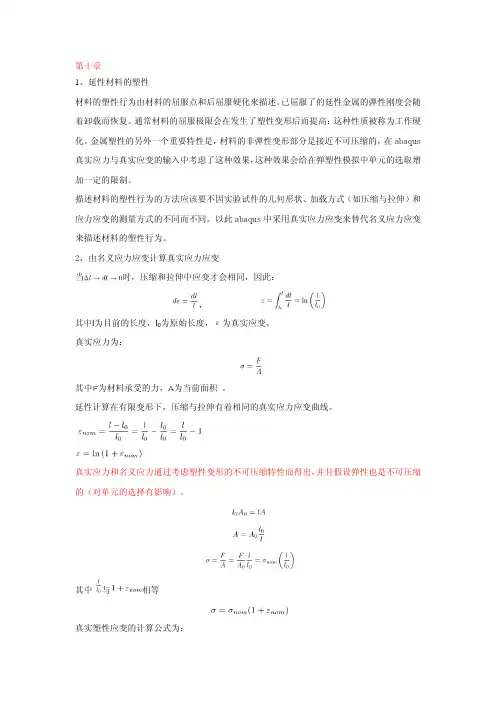
第十章1、延性材料的塑性材料的塑性行为由材料的屈服点和后屈服硬化来描述。
已屈服了的延性金属的弹性刚度会随着卸载而恢复。
通常材料的屈服极限会在发生了塑性变形后而提高:这种性质被称为工作硬化。
金属塑性的另外一个重要特性是,材料的非弹性变形部分是接近不可压缩的,在abaqus 真实应力与真实应变的输入中考虑了这种效果,这种效果会给在弹塑性模拟中单元的选取增加一定的限制。
描述材料的塑性行为的方法应该要不因实验试件的几何形状、加载方式(如压缩与拉伸)和应力应变的测量方式的不同而不同。
以此abaqus中采用真实应力应变来替代名义应力应变来描述材料的塑性行为。
2、由名义应力应变计算真实应力应变当时,压缩和拉伸中应变才会相同,因此:,其中l为目前的长度,l0为原始长度,ε为真实应变。
真实应力为:其中F为材料承受的力,A为当前面积。
延性计算在有限变形下,压缩与拉伸有着相同的真实应力应变曲线。
真实应力和名义应力通过考虑塑性变形的不可压缩特性而得出,并且假设弹性也是不可压缩的(对单元的选择有影响)。
其中与相等真实塑性应变的计算公式为:其中为真实应变,真实弹性应变,真实塑性应变,σ为真实应力,E弹性模量。
3、为了提高计算效率,Explicit计算中,abaqus会把材料数据规则化。
材料数据可以是温度、外场和内部状态变量,比如塑性变形的函数。
在计算过程中的每个状态材料性质必须通过差值法来得到,为了提高计算效率,abq/Explicit将原始输入曲线规则化为应变等距的曲线。
允许误差为3%,最大差值点为200个。
输入数据的最小间距相比应变范围来说太小,数据规则化会有困难,因此在输入的时候要注意这一点。
4、金属材料塑性变形的不可压缩性给弹塑性模拟中单元的选择造成了一定的限制条件。
材料的不可压缩性为给单元添加了动力学约束,单元积分点间的体积必须保持常数。
在某些类型的单元中这种不可压缩性可能使单元过约束。
二阶完全积分实体单元非常容易在模拟不可压缩材料是参数体积自锁,应该避免使用。

ABAQUS分析操作实例ABAQUS分析操作实例—For连接器行业Author:Dream flyDate: 2009-03-04操作流程介绍ABAQUS分析操作实例1.创建部件z ABAQUS CAD功能有限,对于复杂的几何模型一般都由其它CAD软件创建。
1.1 导入端子模型z在主菜单选择FileÆImportÆPart,在弹出的对话框中选择模型保存路径和格式类型。
部件导入对话框导入的端子模型1.2 创建解析刚性面z创建一解析刚性面以便对端子施加位移约束。
z在Module列表中选择Part模块,点击左侧工具区中的(Create Part),弹出Create Part 对话框,Type选择analytical rigid,把界面尺寸适当减小,点击Continue。
z在绘图环境中绘制一直线( ) ,然后点击三次中键确认,输入拉伸深度为1,完成解析刚性面创建。
z在主菜单选择ToolsÆReference point,创建一参考点来约束刚性面。
ABAQUS分析操作实例2.1 创建材料z 在Module 列表中选择Property 模块,点击左侧工具区中的(Create Material),弹出Edit Material 对话框,输入材料名称:C5210R-SH ,点击Mechanical ÆElasticity ÆElastic ,在数据表中设置材料Young’s Modulus 为110000,Poisson’s Ratio 为0.3,然后点击Mechanical ÆPlasticity ÆPlastic 输入两组材料塑性数据(710,0),(764,0.18),点击OK 。
2.1 创建截面属性z 点击左侧工具区中的(Create Section),点击Continue ,在弹出的Edit Section 对话框中,保持默认参数不变,点击OK 。
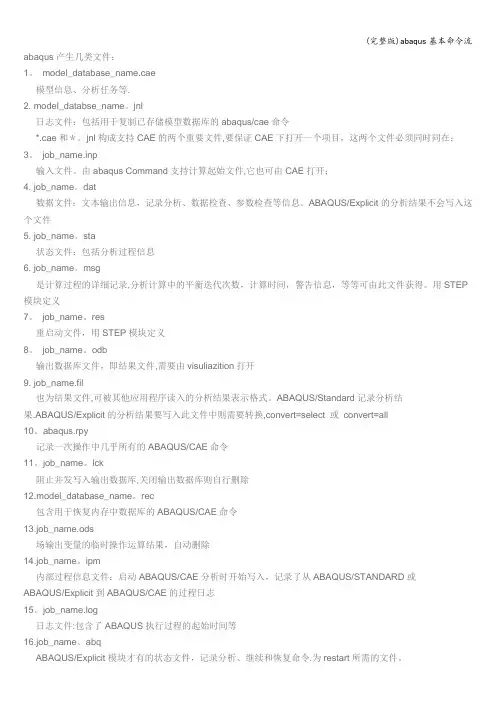
abaqus产生几类文件:1。
model_database_name.cae模型信息、分析任务等.2. model_databse_name。
jnl日志文件:包括用于复制已存储模型数据库的abaqus/cae命令*.cae和*。
jnl构成支持CAE的两个重要文件,要保证CAE下打开一个项目,这两个文件必须同时同在;3。
job_name.inp输入文件。
由abaqus Command支持计算起始文件,它也可由CAE打开;4. job_name。
dat数据文件:文本输出信息,记录分析、数据检查、参数检查等信息。
ABAQUS/Explicit的分析结果不会写入这个文件5. job_name。
sta状态文件:包括分析过程信息6. job_name。
msg是计算过程的详细记录,分析计算中的平衡迭代次数,计算时间,警告信息,等等可由此文件获得。
用STEP 模块定义7。
job_name。
res重启动文件,用STEP模块定义8。
job_name。
odb输出数据库文件,即结果文件,需要由visuliazition打开9. job_name.fil也为结果文件,可被其他应用程序读入的分析结果表示格式。
ABAQUS/Standard记录分析结果.ABAQUS/Explicit的分析结果要写入此文件中则需要转换,convert=select 或convert=all10。
abaqus.rpy记录一次操作中几乎所有的ABAQUS/CAE命令11。
job_name。
lck阻止并发写入输出数据库,关闭输出数据库则自行删除12.model_database_name。
rec包含用于恢复内存中数据库的ABAQUS/CAE命令13.job_name.ods场输出变量的临时操作运算结果,自动删除14.job_name。
ipm内部过程信息文件:启动ABAQUS/CAE分析时开始写入,记录了从ABAQUS/STANDARD或ABAQUS/Explicit到ABAQUS/CAE的过程日志15。
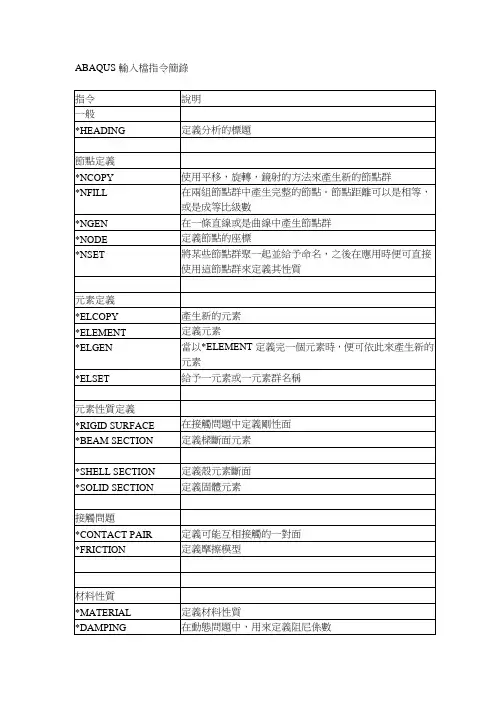
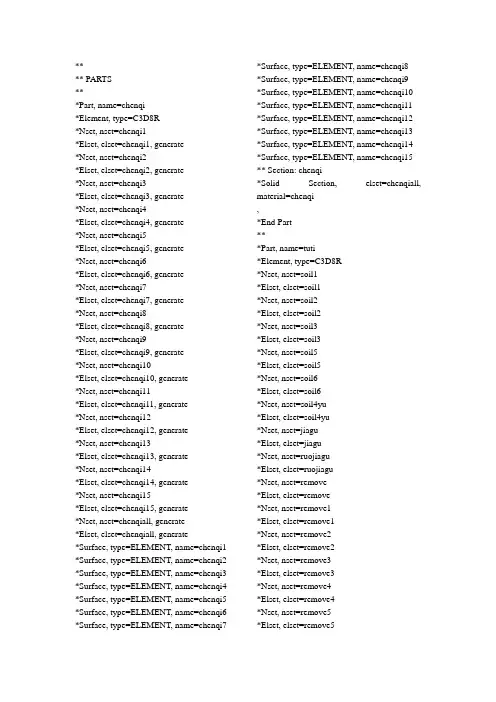
**** PARTS***Part, name=chenqi*Element, type=C3D8R*Nset, nset=chenqi1*Elset, elset=chenqi1, generate*Nset, nset=chenqi2*Elset, elset=chenqi2, generate*Nset, nset=chenqi3*Elset, elset=chenqi3, generate*Nset, nset=chenqi4*Elset, elset=chenqi4, generate*Nset, nset=chenqi5*Elset, elset=chenqi5, generate*Nset, nset=chenqi6*Elset, elset=chenqi6, generate*Nset, nset=chenqi7*Elset, elset=chenqi7, generate*Nset, nset=chenqi8*Elset, elset=chenqi8, generate*Nset, nset=chenqi9*Elset, elset=chenqi9, generate*Nset, nset=chenqi10*Elset, elset=chenqi10, generate*Nset, nset=chenqi11*Elset, elset=chenqi11, generate*Nset, nset=chenqi12*Elset, elset=chenqi12, generate*Nset, nset=chenqi13*Elset, elset=chenqi13, generate*Nset, nset=chenqi14*Elset, elset=chenqi14, generate*Nset, nset=chenqi15*Elset, elset=chenqi15, generate*Nset, nset=chenqiall, generate*Elset, elset=chenqiall, generate*Surface, type=ELEMENT, name=chenqi1 *Surface, type=ELEMENT, name=chenqi2 *Surface, type=ELEMENT, name=chenqi3 *Surface, type=ELEMENT, name=chenqi4 *Surface, type=ELEMENT, name=chenqi5 *Surface, type=ELEMENT, name=chenqi6 *Surface, type=ELEMENT, name=chenqi7 *Surface, type=ELEMENT, name=chenqi8*Surface, type=ELEMENT, name=chenqi9*Surface, type=ELEMENT, name=chenqi10 *Surface, type=ELEMENT, name=chenqi11 *Surface, type=ELEMENT, name=chenqi12 *Surface, type=ELEMENT, name=chenqi13 *Surface, type=ELEMENT, name=chenqi14 *Surface, type=ELEMENT, name=chenqi15 ** Section: chenqi*Solid Section, elset=chenqiall, material=chenqi,*End Part***Part, name=tuti*Element, type=C3D8R*Nset, nset=soil1*Elset, elset=soil1*Nset, nset=soil2*Elset, elset=soil2*Nset, nset=soil3*Elset, elset=soil3*Nset, nset=soil5*Elset, elset=soil5*Nset, nset=soil6*Elset, elset=soil6*Nset, nset=soil4yu*Elset, elset=soil4yu*Nset, nset=jiagu*Elset, elset=jiagu*Nset, nset=ruojiagu*Elset, elset=ruojiagu*Nset, nset=remove*Elset, elset=remove*Nset, nset=remove1*Elset, elset=remove1*Nset, nset=remove2*Elset, elset=remove2*Nset, nset=remove3*Elset, elset=remove3*Nset, nset=remove4*Elset, elset=remove4*Nset, nset=remove5*Elset, elset=remove5*Nset, nset=remove6 *Elset, elset=remove6 *Nset, nset=remove7 *Elset, elset=remove7 *Nset, nset=remove8 *Elset, elset=remove8 *Nset, nset=remove9 *Elset, elset=remove9 *Nset, nset=remove10 *Elset, elset=remove10 *Nset, nset=remove11 *Elset, elset=remove11 *Nset, nset=remove12 *Elset, elset=remove12 *Nset, nset=remove13 *Elset, elset=remove13 *Nset, nset=remove14 *Elset, elset=remove14 *Nset, nset=remove15 *Elset, elset=remove15 *Nset, nset=jiagu1*Elset, elset=jiagu1*Nset, nset=jiagu2*Elset, elset=jiagu2*Nset, nset=jiagu3*Elset, elset=jiagu3*Nset, nset=jiagu4*Elset, elset=jiagu4*Nset, nset=jiagu5*Elset, elset=jiagu5*Nset, nset=jiagu6*Elset, elset=jiagu6*Nset, nset=jiagu7*Elset, elset=jiagu7*Nset, nset=jiagu8*Elset, elset=jiagu8*Nset, nset=jiagu9*Elset, elset=jiagu9*Nset, nset=jiagu10*Elset, elset=jiagu10 *Nset, nset=jiagu11*Elset, elset=jiagu11 *Nset, nset=jiagu12*Elset, elset=jiagu12 *Nset, nset=jiagu13*Elset, elset=jiagu13*Nset, nset=jiagu14*Elset, elset=jiagu14*Nset, nset=jiagu15*Elset, elset=jiagu15*Nset, nset=ruojiagu1*Elset, elset=ruojiagu1*Nset, nset=ruojiagu2*Elset, elset=ruojiagu2*Nset, nset=ruojiagu3*Elset, elset=ruojiagu3*Nset, nset=ruojiagu4*Elset, elset=ruojiagu4*Nset, nset=ruojiagu5*Elset, elset=ruojiagu5*Nset, nset=ruojiagu6*Elset, elset=ruojiagu6*Nset, nset=ruojiagu7*Elset, elset=ruojiagu7*Nset, nset=ruojiagu8*Elset, elset=ruojiagu8*Nset, nset=ruojiagu9*Elset, elset=ruojiagu9*Nset, nset=ruojiagu10*Elset, elset=ruojiagu10*Nset, nset=ruojiagu11*Elset, elset=ruojiagu11*Nset, nset=ruojiagu12*Elset, elset=ruojiagu12*Nset, nset=ruojiagu13*Elset, elset=ruojiagu13*Nset, nset=ruojiagu14*Elset, elset=ruojiagu14*Nset, nset=ruojiagu15*Elset, elset=ruojiagu15*Nset, nset=jiagujiechumian *Elset, elset=jiagujiechumian *Nset, nset=soil3jiagu*Elset, elset=soil3jiagu*Nset, nset=soil3unjiagu*Elset, elset=soil3unjiagu*Nset, nset=soil4unjiagu*Elset, elset=soil4unjiagu*Nset, nset=soil4*Elset, elset=soil4*Nset, nset=tutiz1*Elset, elset=tutiz1*Nset, nset=tutiz2*Elset, elset=tutiz2*Nset, nset=tutix1*Elset, elset=tutix1*Nset, nset=tutix2*Elset, elset=tutix2*Nset, nset=tutidim*Elset, elset=tutidim*Surface, type=ELEMENT, name=tuti1 *Surface, type=ELEMENT, name=tuti2 *Surface, type=ELEMENT, name=tuti3 *Surface, type=ELEMENT, name=tuti4 *Surface, type=ELEMENT, name=tuti5 *Surface, type=ELEMENT, name=tuti6 *Surface, type=ELEMENT, name=tuti7 *Surface, type=ELEMENT, name=tuti8 *Surface, type=ELEMENT, name=tuti9 *Surface, type=ELEMENT, name=tuti10 *Surface, type=ELEMENT, name=tuti11 *Surface, type=ELEMENT, name=tuti12 *Surface, type=ELEMENT, name=tuti13 *Surface, type=ELEMENT, name=tuti14 *Surface, type=ELEMENT, name=tuti15 ** Section: soil4*Solid Section, elset=soil4, material=soil4 ,** Section: soil1*Solid Section, elset=soil1, material=soil1 ,** Section: soil6*Solid Section, elset=soil6, material=soil6 ,** Section: soil2*Solid Section, elset=soil2, material=soil2 ,** Section: soil3*Solid Section, elset=soil3, material=soil3 ,** Section: soil5*Solid Section, elset=soil5, material=soil5 ,*End Part***Part, name=zhujiang*Element, type=C3D8R*Nset, nset=zhujiang1*Elset, elset=zhujiang1, generate*Nset, nset=zhujiang2*Elset, elset=zhujiang2, generate*Nset, nset=zhujiang3*Elset, elset=zhujiang3, generate*Nset, nset=zhujiang4*Elset, elset=zhujiang4, generate*Nset, nset=zhujiang5*Elset, elset=zhujiang5, generate*Nset, nset=zhujiang6*Elset, elset=zhujiang6, generate*Nset, nset=zhujiang7*Elset, elset=zhujiang7, generate*Nset, nset=zhujiang8*Elset, elset=zhujiang8, generate*Nset, nset=zhujiang9*Elset, elset=zhujiang9, generate*Nset, nset=zhujiang10*Elset, elset=zhujiang10, generate*Nset, nset=zhujiang11*Elset, elset=zhujiang11, generate*Nset, nset=zhujiang12*Elset, elset=zhujiang12, generate*Nset, nset=zhujiang13*Elset, elset=zhujiang13, generate*Nset, nset=zhujiang14*Elset, elset=zhujiang14, generate*Nset, nset=zhujiang15*Elset, elset=zhujiang15, generate*Nset, nset=zhujiangall, generate*Elset, elset=zhujiangall, generate*Surface, type=ELEMENT, name=zhuli1 *Surface, type=ELEMENT, name=zhuli2 *Surface, type=ELEMENT, name=zhuli3 *Surface, type=ELEMENT, name=zhuli4 *Surface, type=ELEMENT, name=zhuli5 *Surface, type=ELEMENT, name=zhuli6 *Surface, type=ELEMENT, name=zhuli7*Surface, type=ELEMENT, name=zhuli8*Surface, type=ELEMENT, name=zhuli9*Surface, type=ELEMENT, name=zhuli10*Surface, type=ELEMENT, name=zhuli11*Surface, type=ELEMENT, name=zhuli12*Surface, type=ELEMENT, name=zhuli13*Surface, type=ELEMENT, name=zhuli14*Surface, type=ELEMENT, name=zhuli15*Surface, type=ELEMENT, name=zhuwai1 *Surface, type=ELEMENT, name=zhuwai2 *Surface, type=ELEMENT, name=zhuwai3 *Surface, type=ELEMENT, name=zhuwai4 *Surface, type=ELEMENT, name=zhuwai5 *Surface, type=ELEMENT, name=zhuwai6 *Surface, type=ELEMENT, name=zhuwai7 *Surface, type=ELEMENT, name=zhuwai8 *Surface, type=ELEMENT, name=zhuwai9 *Surface, type=ELEMENT, name=zhuwai10 *Surface, type=ELEMENT, name=zhuwai11 *Surface, type=ELEMENT, name=zhuwai12 *Surface, type=ELEMENT, name=zhuwai13 *Surface, type=ELEMENT, name=zhuwai13 *Surface, type=ELEMENT, name=zhuwai14 *Surface, type=ELEMENT, name=zhuwai15 ** Section: zhujiang*Solid Section, elset=zhujiangall, material=zhujiang,*End Part****** ASSEMBL Y***Assembly, name=Assembly***Instance, name=chenqi-1, part=chenqi*End Instance***Instance, name=tuti-1, part=tuti*End Instance***Instance, name=zhujiang-1, part=zhujiang*End Instance** ** Constraint: Constraint-1*Tie, name=Constraint-1, adjust=yes zhujiang-1.zhuwai1, tuti-1.tuti1** Constraint: Constraint-2*Tie, name=Constraint-2, adjust=yes zhujiang-1.zhuwai2, tuti-1.tuti2** Constraint: Constraint-3*Tie, name=Constraint-3, adjust=yes zhujiang-1.zhuwai3, tuti-1.tuti3** Constraint: Constraint-4*Tie, name=Constraint-4, adjust=yes zhujiang-1.zhuwai4, tuti-1.tuti4** Constraint: Constraint-5*Tie, name=Constraint-5, adjust=yes zhujiang-1.zhuwai5, tuti-1.tuti5** Constraint: Constraint-6*Tie, name=Constraint-6, adjust=yes zhujiang-1.zhuwai6, tuti-1.tuti6** Constraint: Constraint-7*Tie, name=Constraint-7, adjust=yes zhujiang-1.zhuwai7, tuti-1.tuti7** Constraint: Constraint-8*Tie, name=Constraint-8, adjust=yes zhujiang-1.zhuwai8, tuti-1.tuti8** Constraint: Constraint-9*Tie, name=Constraint-9, adjust=yes zhujiang-1.zhuwai9, tuti-1.tuti9** Constraint: Constraint-10*Tie, name=Constraint-10, adjust=yes zhujiang-1.zhuwai10, tuti-1.tuti10** Constraint: Constraint-11*Tie, name=Constraint-11, adjust=yes zhujiang-1.zhuwai11, tuti-1.tuti11** Constraint: Constraint-12*Tie, name=Constraint-12, adjust=yes zhujiang-1.zhuwai12, tuti-1.tuti12** Constraint: Constraint-13*Tie, name=Constraint-13, adjust=yes zhujiang-1.zhuwai13, tuti-1.tuti13** Constraint: Constraint-14*Tie, name=Constraint-14, adjust=yes zhujiang-1.zhuwai14, tuti-1.tuti14** Constraint: Constraint-15*Tie, name=Constraint-15, adjust=yeszhujiang-1.zhuwai15, tuti-1.tuti15** Constraint: Constraint-16*Tie, name=Constraint-16, adjust=yes zhujiang-1.zhuli1, chenqi-1.chenqi1 ** Constraint: Constraint-17*Tie, name=Constraint-17, adjust=yes zhujiang-1.zhuli2, chenqi-1.chenqi2 ** Constraint: Constraint-18*Tie, name=Constraint-18, adjust=yes zhujiang-1.zhuli3, chenqi-1.chenqi3 ** Constraint: Constraint-19*Tie, name=Constraint-19, adjust=yes zhujiang-1.zhuli4, chenqi-1.chenqi4 ** Constraint: Constraint-20*Tie, name=Constraint-20, adjust=yes zhujiang-1.zhuli5, chenqi-1.chenqi5 ** Constraint: Constraint-21*Tie, name=Constraint-21, adjust=yes zhujiang-1.zhuli6, chenqi-1.chenqi6 ** Constraint: Constraint-22*Tie, name=Constraint-22, adjust=yes zhujiang-1.zhuli7, chenqi-1.chenqi7 ** Constraint: Constraint-23*Tie, name=Constraint-23, adjust=yes zhujiang-1.zhuli8, chenqi-1.chenqi8 ** Constraint: Constraint-24*Tie, name=Constraint-24, adjust=yes zhujiang-1.zhuli9, chenqi-1.chenqi9 ** Constraint: Constraint-25*Tie, name=Constraint-25, adjust=yes zhujiang-1.zhuli10, chenqi-1.chenqi10 ** Constraint: Constraint-26*Tie, name=Constraint-26, adjust=yes zhujiang-1.zhuli11, chenqi-1.chenqi11 ** Constraint: Constraint-27*Tie, name=Constraint-27, adjust=yes zhujiang-1.zhuli12, chenqi-1.chenqi12 ** Constraint: Constraint-28*Tie, name=Constraint-28, adjust=yes zhujiang-1.zhuli13, chenqi-1.chenqi13 ** Constraint: Constraint-29*Tie, name=Constraint-29, adjust=yes zhujiang-1.zhuli14, chenqi-1.chenqi14 ** Constraint: Constraint-30 *Tie, name=Constraint-30, adjust=yes zhujiang-1.zhuli15, chenqi-1.chenqi15 *End Assembly**** MATERIALS***Material, name=chenqi*Density2500.,*Elastic2.5e+10, 0.3*Material, name=soil1*Density1900.,*Elastic2e+06, 0.35*Mohr Coulomb14.,0.*Mohr Coulomb Hardening 10000.,0.*Material, name=soil2*Density1890.,*Elastic2.5e+06, 0.3*Mohr Coulomb23.5,0.*Mohr Coulomb Hardening 16000.,0.*Material, name=soil3*Density2020.,*Elastic3e+06, 0.3*Mohr Coulomb18.,0.*Mohr Coulomb Hardening 21000.,0.*Material, name=soil4*Density1990.,*Elastic, dependencies=16e+06, 0.28, , 1.3.6e+06, 0.28, , 2.*Mohr Coulomb33.5,0.*Mohr Coulomb Hardening5000.,0.*Material, name=soil5*Density1930.,*Elastic1e+08, 0.3*Mohr Coulomb19.,0.*Mohr Coulomb Hardening27500.,0.*Material, name=soil6*Density2000.,*Elastic1.5e+08, 0.28*Mohr Coulomb33.,0.*Mohr Coulomb Hardening2000.,0.*Material, name=zhujiang*Density2100.,*Elastic3e+06, 0.2**** INTERACTION PROPERTIES***Surface Interaction, name=IntProp-11.,*Friction, slip tolerance=0.0050.3,*Surface Behavior, pressure-overclosure=HARD**----------------------------------------------------------------***initial conditions,type=field,variable=1tuti-1.remove,1** STEP: geo** *Step, name=geo, nlgeom=YES, unsymm=YES*Geostatic**** BOUNDARY CONDITIONS**** Name: BC-1 Type: Displacement/Rotation *Boundary_PickedSet11, 1, 1** Name: BC-2 Type: Displacement/Rotation *Boundary_PickedSet12, 1, 1** Name: BC-3 Type: Displacement/Rotation *Boundary_PickedSet13, 1, 1_PickedSet13, 2, 2_PickedSet13, 3, 3** Name: BC-4 Type: Displacement/Rotation *Boundarytuti-1.tutix1, 1, 1** Name: BC-5 Type: Displacement/Rotation *Boundarytuti-1.tutix2, 1, 1** Name: BC-6 Type: Displacement/Rotation *Boundarytuti-1.tutiz1, 3, 3** Name: BC-7 Type: Displacement/Rotation *Boundarytuti-1.tutiz2, 3, 3**** LOADS**** Name: zl-chenqi Type: Gravity*Dload_PickedSet9, GRA V, 9.8, 0., -1., 0.** Name: zl-tuti Type: Gravity*Dload_PickedSet8, GRA V, 9.8, 0., -1., 0.** Name: zl-zhujiang Type: Gravity*Dload_PickedSet10, GRA V, 9.8, 0., -1., 0.*model change,removezhujiang-1.zhujiangall,chenqi-1.chenqiall**** OUTPUT REQUESTS***Restart, write, frequency=0*Print, solve=NO**** FIELD OUTPUT: F-Output-1***Output, field, variable=PRESELECT **** HISTORY OUTPUT: H-Output-1***Output, history, variable=PRESELECT *End Step。
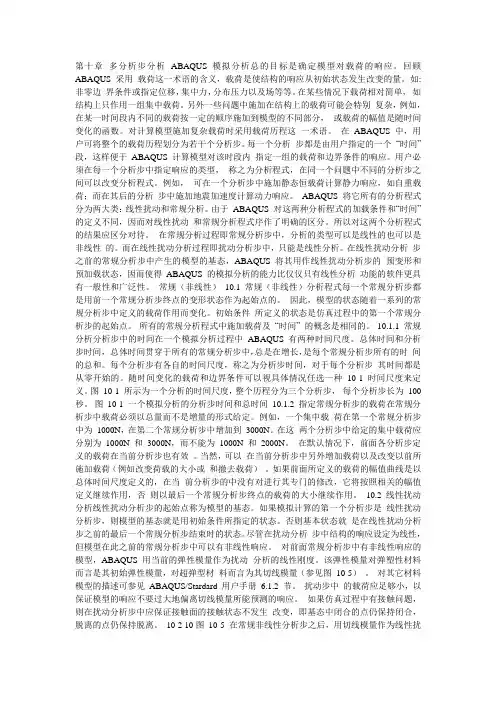
第十章多分析步分析ABAQUS 模拟分析总的目标是确定模型对载荷的响应。
回顾ABAQUS 采用载荷这一术语的含义,载荷是使结构的响应从初始状态发生改变的量。
如:非零边界条件或指定位移,集中力,分布压力以及场等等。
在某些情况下载荷相对简单,如结构上只作用一组集中载荷。
另外一些问题中施加在结构上的载荷可能会特别复杂,例如,在某一时间段内不同的载荷按一定的顺序施加到模型的不同部分,或载荷的幅值是随时间变化的函数。
对计算模型施加复杂载荷时采用载荷历程这一术语。
在ABAQUS 中,用户可将整个的载荷历程划分为若干个分析步。
每一个分析步都是由用户指定的一个―时间‖ 段,这样便于ABAQUS 计算模型对该时段内指定一组的载荷和边界条件的响应。
用户必须在每一个分析步中指定响应的类型,称之为分析程式,在同一个问题中不同的分析步之间可以改变分析程式。
例如,可在一个分析步中施加静态恒载荷计算静力响应,如自重载荷;而在其后的分析步中施加地震加速度计算动力响应。
ABAQUS 将它所有的分析程式分为两大类:线性扰动和常规分析。
由于ABAQUS 对这两种分析程式的加载条件和―时间‖的定义不同,因而对线性扰动和常规分析程式序作了明确的区分。
所以对这两个分析程式的结果应区分对待。
在常规分析过程即常规分析步中,分析的类型可以是线性的也可以是非线性的。
而在线性扰动分析过程即扰动分析步中,只能是线性分析。
在线性扰动分析步之前的常规分析步中产生的模型的基态,ABAQUS 将其用作线性扰动分析步的预变形和预加载状态,因而使得ABAQUS 的模拟分析的能力比仅仅只有线性分析功能的软件更具有一般性和广泛性。
常规(非线性)10.1 常规(非线性)分析程式每一个常规分析步都是用前一个常规分析步终点的变形状态作为起始点的。
因此,模型的状态随着一系列的常规分析步中定义的载荷作用而变化。
初始条件所定义的状态是仿真过程中的第一个常规分析步的起始点。
所有的常规分析程式中施加载荷及―时间‖ 的概念是相同的。
ABAQUS 分析步骤简介ABAQUS 是一种强大的通用有限元分析软件,广泛应用于工程领域。
本文将介绍使用 ABAQUS 执行分析的一般步骤。
步骤一:准备模型在开始分析之前,需要准备一个包含几何形状和材料属性的模型。
可以使用ABAQUS 提供的建模工具或者其他 CAD 软件来构建模型。
确保模型具有适当的尺寸和几何形状,同时为材料分配适当的属性。
步骤二:定义边界条件在进行分析之前,需要定义边界条件。
这包括约束和加载。
约束定义模型上的固定边界或自由边界,加载定义施加到模型上的力或压力。
步骤三:生成网格完成模型和边界条件的定义后,需要在模型上生成网格。
ABAQUS 使用有限元方法进行分析,因此需要将模型离散成许多小单元。
可以根据应用的需要选择不同类型的网格单元。
步骤四:设置分析类型和参数在进行分析之前,需要选择适当的分析类型。
ABAQUS 支持静态、动态、非线性、热传导等多种分析类型。
根据需要进行选择,并设置相应的参数,如分析步数、时间步长、收敛准则等。
步骤五:运行分析设置好分析类型和参数后,可以通过点击运行按钮或通过命令行启动分析。
ABAQUS 将根据定义的模型、边界条件、网格和参数执行分析。
分析可能需要一段时间才能完成,具体时间取决于模型的复杂性和计算机性能。
步骤六:结果后处理一旦分析完成,可以进行结果的后处理。
ABAQUS 提供了丰富的后处理功能,可以通过图形界面或脚本进行结果可视化、数据提取和报告生成。
总结以上是使用 ABAQUS 执行分析的一般步骤。
准备模型、定义边界条件、生成网格、设置分析类型和参数、运行分析以及结果后处理是执行任何分析任务的关键步骤。
掌握这些步骤将使您能够更好地使用 ABAQUS 进行工程分析。
abaqus常用命令abaqus常用指令小结*HEADING 定义分析的标题,输出地显示示窗口,无参数。
数据行:1、标题标题可以是几行长,但只有第一行的前80个字符会被保存并显示。
*RESTART保存重用数据及分析结果本选项可能导致产生大量数据。
用于控制重启数据的要求读,至少有以下一个参数:READ:本次分析是对前次分析的重启,基本模型定义数据(单元、材料、结点)本次重启不能更改;但是单元集、结点集、振幅表可以增加,本部件并发产生的历史数据可能改变已分析产生的历史数据。
WRITE:本次分析将写入重启数据。
如果使用了READ参数以下能数可选:ENDSTEP:用户希望在该点终止现在的STEP与STED相对使用INC:使本参数等于“STEP”参数定义的步骤数之内的一个增量,在读步后可以重新进行分析STEP:本参数等于重启时的步骤数,省略时分析在最后一步重启如果使用了WRITE参数以下参数可选FREQVENCY:重启信息数据写入的频率,如FREQVENCY=2则在第2、4、6…步时写入数据。
FREQVENCY=0则停止重启数据的写入OVERLAY:覆盖上一步所产生的数据,省略则写入每步的数据*NODE定义结点,用于通过坐标直接定义结点。
可选参数INPVT:等于外部数据文件名NSET:等于节点集的名称SYSTEM:缺省SYSYEM=R代表坐标直角点(X、Y、Z),SYSTEM=C代表圆柱坐标(R、θ、Z),SYSTEM=S代表球坐标(R、θ、?)定义节点的数据行:第一行数据:1、节点号2、节点坐标第一分量3、节点坐标第二分量4、节点坐标第三分量5、与标准节点间的第一方向导弦(可选参数)6、与标准节点间的第二方向导弦(可选参数),圆柱坐标或球形坐标数为角度(度数)7、与标准节点间的第三方向导弦(可选参数),圆柱坐标或球形坐标数为角度(度数)重复以上数据行定义多个结点*NGEN依次产生结点可选参数:LINE:LINE=P接抛物线产生结点,用户必须定义额外的点,该中点在两端点之间,LINE=C 接圆弧线方式产生结点,用户必须定义额外的点,该点是圆弧的中心,省略的话接直线方式产生。
经验值 1960美味虾36注册日期 2005-4-13 最近登陆 2011-12-22 来自江西-九江状态2009-8-20 16:53 t T#1ABAQUS帮助里关键字(keywords)翻译总规则1、关键字必须以*号开头,且关键字前无空格2、**为注释行,它可以出现在文件中的任何地方3、当关键字后带有参数时,关键词后必须采用逗号隔开4、参数间都采用逗号隔开5、关键词可以采用简写的方式,只要程序能识别就可以了6、不需使用隔行符,如果参数比较多,一行放不下,可以另起一行,只要在上一行的末尾加逗号便可以*AMPLITUDE:定义幅值曲线这个选项允许任意的载荷、位移和其它指定变量的数值在一个分析步中随时间的变化(或者在ABAQUS/Standard分析中随着频率的变化)。
必需的参数:NAME:设置幅值曲线的名字可选参数:DEFINITION:设置definition=Tabular(默认)给出表格形式的幅值-时间(或幅值-频率)定义。
设置DEFINITION=EQUALLY SPACED/PERIODIC/MODULATED/DECAY/SMOOTH STEP/SOLUTION DEPENDENT或BUBBLE来定义其他形式的幅值曲线。
INPUT:设置该参数等于替换输入文件名字。
TIME:设置TIME=STEP TIME(默认)则表示分析步时间或频率。
TIME=TOTAL TIME表示总时间。
VALUE:设置VALUE=RELATIVE(默认),定义相对幅值。
VALUE=ABSOLUTE表示绝对幅值,此时,数据行中载荷选项内的值将被省略,而且当温度是指定给已定义了温度TEMPERATURE=GRADIENTS(默认)梁上或壳单元上的节点,不能使用ABSOLUTE。
对于DEFINITION=TABULAR的可选参数:SMOOTH:设置该参数等于DEFINITION=TABULAR的数据行第一行1、时间或频率2、第一点的幅值(绝对或相对)3、时间或频率4、第二点的幅值(绝对或相对) 等等基本形式:*Amplitude,name=Amp-10.,0.,0.2,1.5,0.4,2.,1.,1.*BEAM SECTION:当需要数值积分时定义梁截面*BOND:定义绑定和绑定属性*BOUNDARY:定义边界条件用来在节点定义边界条件或在子模型分析中指定被驱动的节点。
ABAQUS分析步ABAQUS是一款非常强大的有限元分析软件。
在使用ABAQUS进行分析时,需要按照一定的步骤进行操作。
本文将从ABAQUS分析步的基本概念出发,ABAQUS分析步的流程和注意事项。
ABAQUS分析步的概念在ABAQUS中,一个分析步是指将模型在求解连续的时间步骤中间分割成一系列的时间段。
每个时间段包含了一组数学描述,用以定义特定的问题。
在每个时间段中,ABAQUS都会解出一个瞬态分析问题,并且考虑该时间段中任何荷载的影响。
当模拟时间段被分割成一系列固定的时间段后,模拟可以被解出并考虑所有时间段的影响。
ABAQUS中的每个分析步可以被分为以下几个部分:•定义分析步的类型,例如静态分析、瞬态分析、一般步骤分析等等;•定义材料特性、边界条件和载荷类型;•将时间分段,以便ABAQUS在每个时间段中计算模型的响应;•运行ABAQUS求解模型。
ABAQUS分析步流程下面将介绍ABAQUS分析步的流程。
步骤1:选择分析步骤类型在开始ABAQUS模拟时,需要选择合适的分析步骤类型。
分析步骤类型决定了所必需的各种物理和数学尺度,以及求解器选项,以解决特定问题。
例如,若要解决一个静态模拟问题,则需要选择静态步骤。
若要解决一个瞬态问题,则需要选择瞬态步骤。
在选择分析步骤类型后,需要对步骤进行设置,以定义时间、载荷和荷载条件等。
步骤2:定义模型的物理属性在进行ABAQUS分析之前,需要定义模型的物理属性以包括材料特性、约束和载荷。
为此,可以定义模型的分析平面,以及每个单元的属性。
可以选择不同类型的元素进行分析,并且因为ABAQUS支持多层的模型设计和仿真,在开始模拟之前,需要确保模型中的所有单元和材料的属性相同。
步骤3:定义连续的时间分析段在进行任何类型的分析之前,需要将整个时间范围分成若干时间段。
这个时间段可以根据用户需求进行设置。
每个时间段中,都可以设置模拟求解器选项以确保求解器在模拟过程中正常运行。
Abaqus常用DOS命令总结
(2015-07-03 11:27:46)
转载▼
标签:
杂谈
1)abaqus help:可以显示所有ABAQUS命令的语法规则
2)abaqus cae:启动ABAQUS/CAE
3)abaqus job=job_name:提交分析作业
注:提交的*.inp必须要在ABAQUS默认的工作目录下
4)abaqus python script_file:运行脚本文件。
script_file是脚本文件名称
注:如果没有给出脚本文件名称,则进入脚本语言界面
5)abaqus findkeyword:在帮助文档中找到包含所需关键词的INP文件。
如包含重启动
*RESTART的INP文件
6)abaqus fetch job=job name:提取帮助文档中所提供的INP文件、用户子程序和JNL文件等。
提取后的文件保存在ABAQUS默认工作目录下
注:可以利用5)查找所需INP文件,然后利用6)将其提取出来
7)abaqus doc:打开ABAQUS的帮助文档
8)abaqus viewer:进入ABAQUS/CAE的Vissualization模块
9)abaqus append:将两个结果文件*.fil合并到一起。
abaqus系列教程多步骤分析11 多步骤分析ABAQUS模拟分析的一般性目标是确定模型对所施加载荷的响应。
回顾术语载荷(load)在ABAQUS中的一般性含义,载荷代表了使结构的响应从它的初始状态到发生变化的任何事情;例如:非零边界条件或施加的位移、集中力、压力以及场等等。
在某些情况下载荷可能相对简单,如在结构上的一组集中载荷。
在另外一些问题中施加在结构上的载荷可能会相当复杂,例如,在某一时间段内,不同的载荷按一定的顺序施加到模型的不同部分,或载荷的幅值是随时间变化的函数。
采用术语载荷历史(load history)以代表这种作用在模型上的复杂载荷。
在ABAQUS中,用户将整个的载荷历史划分为若干个分析步(step)。
每一个分析步是由用户指定的一个“时间”段,在该时间段内ABAQUS计算该模型对一组特殊的载荷和边界条件的响应。
在每一个分析步中,用户必须指定响应的类型,称之为分析过程,并且从一个分析步到下一个分析步,分析过程也可能发生变化。
例如,可以在一个分析步中施加静态恒定载荷,有可能是自重载荷;而在下一个分析步中计算这个施加了载荷的结构对于地震加速度的动态响应。
隐式和显式分析均可以包含多个分析步骤;但是,在同一个分析作业中不能够组合隐式和显式分析。
为了组合一系列的隐式和显式分析步,可以应用结果传递或输入功能。
在ABAQUS分析用户手册(ABAQUS Analysis User’s Manual)第7.7.2节“Transfering results between ABAQUS/Explicit and ABAQUS/Standard”中讨论了这个功能。
而本指南不做进一步的讨论。
ABAQUS将它的所有分析过程主要划分为两类:线性扰动(linear perturbation)和一般性分析(general)。
在ABAQUS/Standard或在ABAQUS/Explicit分析中可以包括一般分析步;而线性扰动分析步只能用于ABAQUS/Standard分析。